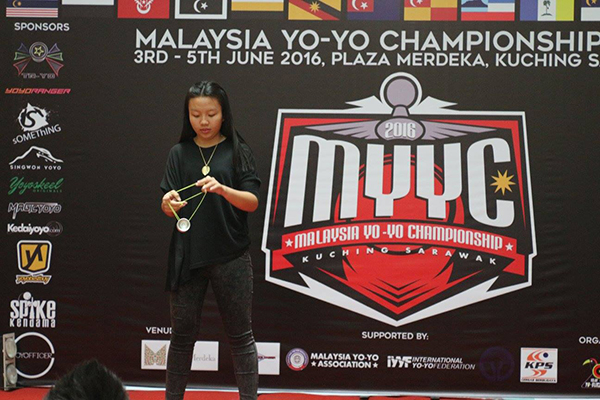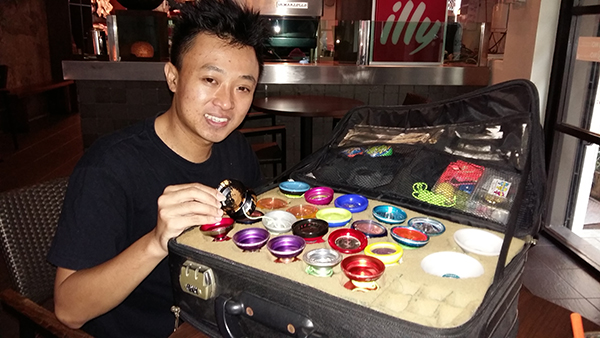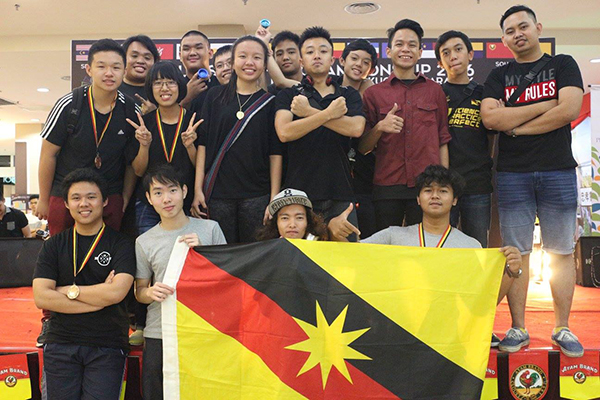
Chung’s new apprentice, Phiong Shuk Chian, performs at the MYYC 2016.
IT looks simple and ordinary and playing it may seem very childish.
But with a history dating back at least 2,500 years — and still spiralling up and down a string like an ever spinning reel more than two millennia later today — it’s something that looks set to remain as a durable fixture in the world of toys for a long while yet.
Yes, it’s the yoyo, a knobby object attached to a string which, when manoeuvred by a skilled player, seems to come alive on its own, bobbing and swaying acrobatically like a big fly that refuses to be shooed away.
Invented in ancient Greece and first made popular in the 1920’s, yo-yoing has remained a popular pastime for many generations and cultures. In the simplest play, the string is wound on the spool by hand, the yoyo is then thrown downwards, hitting the end of the string and winding up the string towards the hand again before being finally grabbed and ready to be thrown again.
One of the most basic tricks is “the sleeper” where the yoyo spins at the end of the string for a noticeable amount of time before returning to the hand. Another popular trick is “walk the dog” which is done by throwing a strong sleeper and allowing the yoyo to roll across the floor before tugging it back to the hand.
Although many people may look upon this toy as a mere object of amusement, and playing it as nothing more than a hobby, professional yoyo thrower Ryan Chung Chuan is on some sort of mission to try to get yoyo recognised as a sport. His vision is to transform the game of yo-yoing in Malaysia from a child’s pastime into a competitive sport for all ages of players.
Chung, a yoyo enthusiast since 2004, felt it was important for yoyo to be recognised as a competitive sport because it is an athletic activity, requiring skills or physical prowess, and often of a competitive nature. Get him started on his favourite game and you will hear about things such as bearings, metal alloys, rims, axles, silicone, hubstacks, plastic, titanium and brass.
“If yoyo is never a sport, what’s the point of playing it? People say oh, it’s just a hobby, a pastime.
“But where can this hobby lead you? Nowhere. If you look at it from a different concept — like yoyo being recognised as a competitive sport — then you can make it more than just a hobby. Players will have a goal to achieve. Say, if it could get into Sukma as a medal event, then the participating states would be motivated to train up players. And if the players are good, they can even compete in international events like the World Yoyo Contest.
“It’s possible to achieve such a goal even in Sarawak with the opportunity and support to promote the game,” he said.
In the US, yoyo is recognised as a sport, attracting overwhelming response to competitions. Players will take part in regional meets before graduating to national and international levels.
Chung’s confidence in yoyo’s recognition as a competitive sport in Malaysia received a big boost when his sports club — Yo-Blitz Kuching — was officially registered in February, 2015, after seven long years of trying.
“This would not have been possible without support from the Social Development Ministry and Audie Chua, president of Rakan Bestnye Sarawak,” he acknowledged.
Chung first met Chua at 1BFF Recreation Club Pending in 2014 and the latter has since been a staunch supporter of his vision and effort.
Chung noted it was amazing how the yoyo scene in Kuching had changed from the time he first started to play. He remembers after forming Yo-Blitz Kuching with his friend Peter Henry Demong, they found it really tough introducing yoyo to the public at the time.
They were mocked and laughed at with “only bad comments.” But they stuck with it and soon things got a little bit better. In 2008, Chung travelled to Kuala Lumpur to learn more about yo-yoing as well as compete in the Malaysia Yo-Yo Championship (MYYC) 2008. Since then, he and Peter have been trying to organise yoyo contests but were never really successful until in 2010 when they managed to put together the first Sarawak Regional Yoyo Contest in collaboration with Sara Urusharta at the Kuching Waterfront.
That kick-started a series of competitions like the Sarawak Regional Yoyo Contest, the Kuching Yoyo Contest, the Malaysia Yoyo Ultimate Challenge, and the Kota Samarahan Yoyo Contest – all organised by Chung.
Y-Blitz winning the bid to host the Malaysia Yoyo Championship 2016 for the first time in Kuching (from June 3 to 5 at Merdeka Plaza) put the latest feather in Chung’s cap. The club secured the rights to host the first ever national yoyo contest outside Kuala Lumpur. The championship was first held in Kuala Lumpur in 2005 – 11 years ago.
Chung is grateful to Malaysia Yoyo Association president Muhammad Shakeel for recognising Sarawak’s potential to host the event amidst growing local interests in the game.
History of yoyo
According to Chung, the yoyo craze in Malaysia started in 1999 when Yo Hans came to Malaysia as part of a world tour to promote yoyo as a toy. Han’s salesmanship and skills with the yoyo grabbed the public’s attention and many became interested, especially after seeing how he pushed the limits of his yo-yoing prowess.
However, after a spell of yo-yoing mania, things went cold with only a small yoyo fraternity keeping interests alive. Apparently, these die-hard players saw the uniqueness of yo-yoing and continued experimenting with new tricks.
Even though the craze has faded, Hans is still widely respected by the leaders, champions and enthusiasts of the game. He is one of the best known yoyo personalities — as a competitor, demonstrator for Playmzxx/ProYo and manufacturer-owner of Playmaxx and YoYoFactory.
In 2005, he bettered his Guinness World Record of 51 yoyo tricks in one minute. The following year, he “unofficially” broke this record during a “F.A.S.T” promotion in Singapore, conjuring up 62 yoyo tricks in 60 seconds.
The yoyo wave swamped Kuching in earnest in 2004 with the arrival of the brand called Super Yoyo — a Japanese Manga series, adapted into an anime TV series, airing on NTV7 and sparking a resurgence of yoyo craze among locals.
However, the passion died out after 2004 with only a handful of throwers left in Kuching. Three years later (2007), Chung formed a team with another surviving player to try and revive the game by promoting the yoyo as more than just a toy. But interests did not pick up as expected.

Chung and his yoyo collection.
Yo-yoing injuries
Chung reckoned 90 per cent of serious yoyoists could get injured if they pushed the limits because a fast yoyo was like a dangerous device. If not handled skilfully, the wooden or metal disc whirling at high speed could spin out of control and land smack on the thrower’s body — frequently the face.
Injuries include finger cuts and torn lips, brows and cheeks but most involve minor blows to the face and scalp. Proper training helps prevent injuries to both novices and experts alike.
“I get injuries all the time – with serious cuts on my face. One must take precaution when practising,” he advised.
Yoyo evolving fast
Although the yoyo had been around for centuries, it was the competition craze that made it one of the most popular toys of the 20th century.
Yo-yoing is fast evolving with new tricks being developed everyday. Back in those days when the game was all about coming up with tricks like Rock the baby, Walk the dog, Eiffel Tower, Round the World, Brain Twister and Elevator, people in the know were able to readily name the stunts a thrower was pulling.
“But little did they know yo-yoing had started evolving since the very beginning till now. Tricks performed then and now are very different,” Chung said, adding that back then, only simple tricks were used but now there are combos, elements, styles, choreographs, music and modern tricks like finger-spin, horizontal, shoulder complex, behind the back, speed tricks, flow, slack, hop trick, pop tricks, front style and many more.
“The game has been evolving every single day. If you were missing in action for one month, you would be surprised how many tricks with new combos would have been created in that time,” Chung explained.
Early yoyos were made of plastic and wood, using systems such as brake pads, stickers starburst, nylon axle and wood axle. Modern yoyos, on the other hand, consist of metal types such as 6061, 6063 and 7075 as well as plastic, celcon, Bi Metal, and brass. Most modern yoyos work by metal bearings — eight ball bearings, 10 balls as well as silicone pads.
Today’s yoyos have modern designs to enable players to create even more tricks. The “Imperial Shape” is very common and considered the original yoyo shape. This design helps with performing looping tricks.
The “Modified Shape” is a very popular design for looping-style tricks, producing a long spinning time. It usually has a hollow face, sometimes covered with paper or plastic with extra material in the rim.
The “Butterfly” shape is good for string tricks but usually loops very poorly, looking as though the separated halves of a standard yoyo have been reconnected back-to-back. The wider string gap makes it easier to catch the yoyo on the string.
Other modern shapes are V-shape, W-shape, O-Shape and H-Shape.

The Sarawak team at the MYCC 2016.
Various tricks
Weight is the key to a manoeuvrable yoyo, according to Chung.
Extra weight on the outside rims will give a longer spinning time. The balance between weight and design is important. Players do a set musical routine when competing with different categories of yoyo models. Popular tricks today are horizontal, speed tricks; flow, banger tricks; behind-the-back tricks and complicated trick combos.
Usually, beginners start with the long sleeper, following up with feats like walk the dog, forward pass, breakaway, elevator, UFO, trapeze, double or nothing and Eiffel Tower. On reaching an expert level, they will go for boing boing, eli hop, horizontal tricks, grind, finger spin, under the leg, behind the back, circular tricks and so on.
At this point of interview, Chung stood up, grabbed a yoyo off the table and flipped it into a high-speed trick routine. It was amazing to watch.
Yo-yoing might still be finding its way as a sport but the pros now definitely have the tools to make it happen.
“I should say I’m confident one day our government will recognise it as a sport. Generally, the scenario seems more positive now and more parents are allowing their children to master the skills.
“Even if it (yoyo) is not recognised as a competitive sport, I’m still happy because I have tried my best to make it happen. Everyone has dreams and dreams do come true — only a question of whether or not you want to make it come true,” he said.
Chung won the Sarawak Regional Yoyo Contest in 2011 and 2013 and finished among the top three in the Off-String Division of the Malaysia National Yoyo Contest in Kuala Lumpur. He placed third in the 2013 International Division of the Brunei National Yoyo Contest, won the X Division of the 2015 Sabah Open Yoyo Championship and finished runner-up in the 4A Off-String Division of the 2015 Malaysia Yoyo Championship.
He also took part in the Asia Pacific Yoyo Championship in Singapore in 2010 and 2013.
